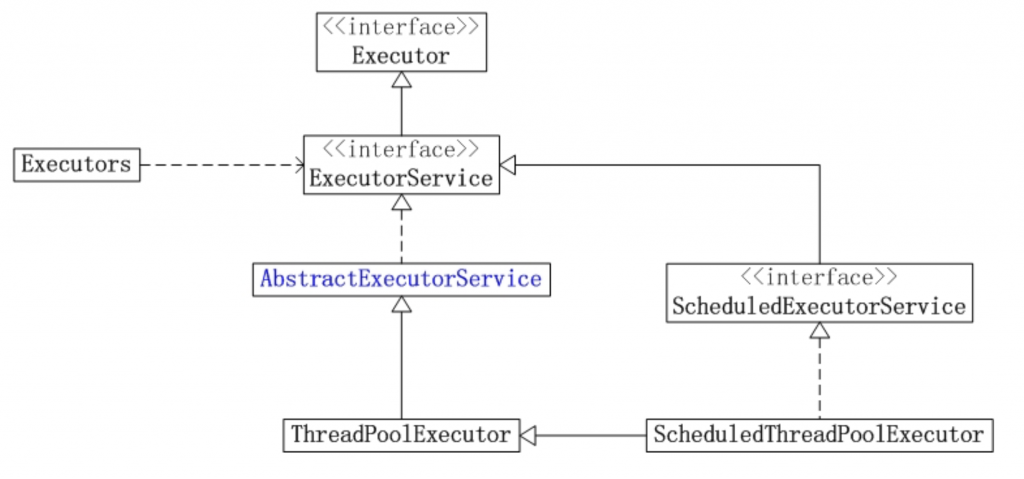阅读完需:约 24 分钟
线程池架构图

1. Executor
它是”执行者”接口,它是来执行任务的。准确的说,Executor提供了execute()接口来执行已提交的 Runnable 任务的对象。Executor存在的目的是提供一种将”任务提交”与”任务如何运行”分离开来的机制。
它只包含一个函数接口:
void execute(Runnable command)2. ExecutorService
ExecutorService继承于Executor。它是”执行者服务”接口,它是为”执行者接口Executor”服务而存在的;准确的话,ExecutorService提供了”将任务提交给执行者的接口(submit方法)”,”让执行者执行任务(invokeAll, invokeAny方法)”的接口等等。
ExecutorService的函数列表
// 请求关闭、发生超时或者当前线程中断,无论哪一个首先发生之后,都将导致阻塞,直到所有任务完成执行。
boolean awaitTermination(long timeout, TimeUnit unit)
// 执行给定的任务,当所有任务完成时,返回保持任务状态和结果的 Future 列表。
<T> List<Future<T>> invokeAll(Collection<? extends Callable<T>> tasks)
// 执行给定的任务,当所有任务完成或超时期满时(无论哪个首先发生),返回保持任务状态和结果的 Future 列表。
<T> List<Future<T>> invokeAll(Collection<? extends Callable<T>> tasks, long timeout, TimeUnit unit)
// 执行给定的任务,如果某个任务已成功完成(也就是未抛出异常),则返回其结果。
<T> T invokeAny(Collection<? extends Callable<T>> tasks)
// 执行给定的任务,如果在给定的超时期满前某个任务已成功完成(也就是未抛出异常),则返回其结果。
<T> T invokeAny(Collection<? extends Callable<T>> tasks, long timeout, TimeUnit unit)
// 如果此执行程序已关闭,则返回 true。
boolean isShutdown()
// 如果关闭后所有任务都已完成,则返回 true。
boolean isTerminated()
// 启动一次顺序关闭,执行以前提交的任务,但不接受新任务。
void shutdown()
// 试图停止所有正在执行的活动任务,暂停处理正在等待的任务,并返回等待执行的任务列表。
List<Runnable> shutdownNow()
// 提交一个返回值的任务用于执行,返回一个表示任务的未决结果的 Future。
<T> Future<T> submit(Callable<T> task)
// 提交一个 Runnable 任务用于执行,并返回一个表示该任务的 Future。
Future<?> submit(Runnable task)
// 提交一个 Runnable 任务用于执行,并返回一个表示该任务的 Future。
<T> Future<T> submit(Runnable task, T result)3. AbstractExecutorService
AbstractExecutorService是一个抽象类,它实现了ExecutorService接口。
AbstractExecutorService存在的目的是为ExecutorService中的函数接口提供了默认实现。
AbstractExecutorService函数列表
由于它的函数列表和ExecutorService一样,这里就不再重复列举了。
4. ThreadPoolExecutor
ThreadPoolExecutor就是大名鼎鼎的”线程池”。它继承于AbstractExecutorService抽象类。
ThreadPoolExecutor函数列表
// 用给定的初始参数和默认的线程工厂及被拒绝的执行处理程序创建新的 ThreadPoolExecutor。
ThreadPoolExecutor(int corePoolSize, int maximumPoolSize, long keepAliveTime, TimeUnit unit, BlockingQueue<Runnable> workQueue)
// 用给定的初始参数和默认的线程工厂创建新的 ThreadPoolExecutor。
ThreadPoolExecutor(int corePoolSize, int maximumPoolSize, long keepAliveTime, TimeUnit unit, BlockingQueue<Runnable> workQueue, RejectedExecutionHandler handler)
// 用给定的初始参数和默认被拒绝的执行处理程序创建新的 ThreadPoolExecutor。
ThreadPoolExecutor(int corePoolSize, int maximumPoolSize, long keepAliveTime, TimeUnit unit, BlockingQueue<Runnable> workQueue, ThreadFactory threadFactory)
// 用给定的初始参数创建新的 ThreadPoolExecutor。
ThreadPoolExecutor(int corePoolSize, int maximumPoolSize, long keepAliveTime, TimeUnit unit, BlockingQueue<Runnable> workQueue, ThreadFactory threadFactory, RejectedExecutionHandler handler)
// 基于完成执行给定 Runnable 所调用的方法。
protected void afterExecute(Runnable r, Throwable t)
// 如果在保持活动时间内没有任务到达,新任务到达时正在替换(如果需要),则设置控制核心线程是超时还是终止的策略。
void allowCoreThreadTimeOut(boolean value)
// 如果此池允许核心线程超时和终止,如果在 keepAlive 时间内没有任务到达,新任务到达时正在替换(如果需要),则返回 true。
boolean allowsCoreThreadTimeOut()
// 请求关闭、发生超时或者当前线程中断,无论哪一个首先发生之后,都将导致阻塞,直到所有任务完成执行。
boolean awaitTermination(long timeout, TimeUnit unit)
// 在执行给定线程中的给定 Runnable 之前调用的方法。
protected void beforeExecute(Thread t, Runnable r)
// 在将来某个时间执行给定任务。
void execute(Runnable command)
// 当不再引用此执行程序时,调用 shutdown。
protected void finalize()
// 返回主动执行任务的近似线程数。
int getActiveCount()
// 返回已完成执行的近似任务总数。
long getCompletedTaskCount()
// 返回核心线程数。
int getCorePoolSize()
// 返回线程保持活动的时间,该时间就是超过核心池大小的线程可以在终止前保持空闲的时间值。
long getKeepAliveTime(TimeUnit unit)
// 返回曾经同时位于池中的最大线程数。
int getLargestPoolSize()
// 返回允许的最大线程数。
int getMaximumPoolSize()
// 返回池中的当前线程数。
int getPoolSize()
// 返回此执行程序使用的任务队列。
BlockingQueue<Runnable> getQueue()
// 返回用于未执行任务的当前处理程序。
RejectedExecutionHandler getRejectedExecutionHandler()
// 返回曾计划执行的近似任务总数。
long getTaskCount()
// 返回用于创建新线程的线程工厂。
ThreadFactory getThreadFactory()
// 如果此执行程序已关闭,则返回 true。
boolean isShutdown()
// 如果关闭后所有任务都已完成,则返回 true。
boolean isTerminated()
// 如果此执行程序处于在 shutdown 或 shutdownNow 之后正在终止但尚未完全终止的过程中,则返回 true。
boolean isTerminating()
// 启动所有核心线程,使其处于等待工作的空闲状态。
int prestartAllCoreThreads()
// 启动核心线程,使其处于等待工作的空闲状态。
boolean prestartCoreThread()
// 尝试从工作队列移除所有已取消的 Future 任务。
void purge()
// 从执行程序的内部队列中移除此任务(如果存在),从而如果尚未开始,则其不再运行。
boolean remove(Runnable task)
// 设置核心线程数。
void setCorePoolSize(int corePoolSize)
// 设置线程在终止前可以保持空闲的时间限制。
void setKeepAliveTime(long time, TimeUnit unit)
// 设置允许的最大线程数。
void setMaximumPoolSize(int maximumPoolSize)
// 设置用于未执行任务的新处理程序。
void setRejectedExecutionHandler(RejectedExecutionHandler handler)
// 设置用于创建新线程的线程工厂。
void setThreadFactory(ThreadFactory threadFactory)
// 按过去执行已提交任务的顺序发起一个有序的关闭,但是不接受新任务。
void shutdown()
// 尝试停止所有的活动执行任务、暂停等待任务的处理,并返回等待执行的任务列表。
List<Runnable> shutdownNow()
// 当 Executor 已经终止时调用的方法。
protected void terminated()ThreadPoolExecutor源码解析
1、常用变量的解释
// 1. `ctl`,可以看做一个int类型的数字,高3位表示线程池状态,低29位表示worker数量
private final AtomicInteger ctl = new AtomicInteger(ctlOf(RUNNING, 0));
// 2. `COUNT_BITS`,`Integer.SIZE`为32,所以`COUNT_BITS`为29
private static final int COUNT_BITS = Integer.SIZE - 3;
// 3. `CAPACITY`,线程池允许的最大线程数。1左移29位,然后减1,即为 2^29 - 1
private static final int CAPACITY = (1 << COUNT_BITS) - 1;
// runState is stored in the high-order bits
// 4. 线程池有5种状态,按大小排序如下:RUNNING < SHUTDOWN < STOP < TIDYING < TERMINATED
private static final int RUNNING = -1 << COUNT_BITS;
private static final int SHUTDOWN = 0 << COUNT_BITS;
private static final int STOP = 1 << COUNT_BITS;
private static final int TIDYING = 2 << COUNT_BITS;
private static final int TERMINATED = 3 << COUNT_BITS;
// Packing and unpacking ctl
// 5. `runStateOf()`,获取线程池状态,通过按位与操作,低29位将全部变成0
private static int runStateOf(int c) { return c & ~CAPACITY; }
// 6. `workerCountOf()`,获取线程池worker数量,通过按位与操作,高3位将全部变成0
private static int workerCountOf(int c) { return c & CAPACITY; }
// 7. `ctlOf()`,根据线程池状态和线程池worker数量,生成ctl值
private static int ctlOf(int rs, int wc) { return rs | wc; }
/*
* Bit field accessors that don't require unpacking ctl.
* These depend on the bit layout and on workerCount being never negative.
*/
// 8. `runStateLessThan()`,线程池状态小于xx
private static boolean runStateLessThan(int c, int s) {
return c < s;
}
// 9. `runStateAtLeast()`,线程池状态大于等于xx
private static boolean runStateAtLeast(int c, int s) {
return c >= s;
}2、构造方法
public ThreadPoolExecutor(int corePoolSize,
int maximumPoolSize,
long keepAliveTime,
TimeUnit unit,
BlockingQueue<Runnable> workQueue,
ThreadFactory threadFactory,
RejectedExecutionHandler handler) {
// 基本类型参数校验
if (corePoolSize < 0 ||
maximumPoolSize <= 0 ||
maximumPoolSize < corePoolSize ||
keepAliveTime < 0)
throw new IllegalArgumentException();
// 空指针校验
if (workQueue == null || threadFactory == null || handler == null)
throw new NullPointerException();
this.corePoolSize = corePoolSize;
this.maximumPoolSize = maximumPoolSize;
this.workQueue = workQueue;
// 根据传入参数`unit`和`keepAliveTime`,将存活时间转换为纳秒存到变量`keepAliveTime `中
this.keepAliveTime = unit.toNanos(keepAliveTime);
this.threadFactory = threadFactory;
this.handler = handler;
}3、提交执行task的过程
public void execute(Runnable command) {
if (command == null)
throw new NullPointerException();
/*
* Proceed in 3 steps:
*
* 1. If fewer than corePoolSize threads are running, try to
* start a new thread with the given command as its first
* task. The call to addWorker atomically checks runState and
* workerCount, and so prevents false alarms that would add
* threads when it shouldn't, by returning false.
*
* 2. If a task can be successfully queued, then we still need
* to double-check whether we should have added a thread
* (because existing ones died since last checking) or that
* the pool shut down since entry into this method. So we
* recheck state and if necessary roll back the enqueuing if
* stopped, or start a new thread if there are none.
*
* 3. If we cannot queue task, then we try to add a new
* thread. If it fails, we know we are shut down or saturated
* and so reject the task.
*/
int c = ctl.get();
// worker数量比核心线程数小,直接创建worker执行任务
if (workerCountOf(c) < corePoolSize) {
if (addWorker(command, true))
return;
c = ctl.get();
}
// worker数量超过核心线程数,任务直接进入队列
if (isRunning(c) && workQueue.offer(command)) {
int recheck = ctl.get();
// 线程池状态不是RUNNING状态,说明执行过shutdown命令,需要对新加入的任务执行reject()操作。
// 这儿为什么需要recheck,是因为任务入队列前后,线程池的状态可能会发生变化。
if (! isRunning(recheck) && remove(command))
reject(command);
// 这儿为什么需要判断0值,主要是在线程池构造方法中,核心线程数允许为0
else if (workerCountOf(recheck) == 0)
addWorker(null, false);
}
// 如果线程池不是运行状态,或者任务进入队列失败,则尝试创建worker执行任务。
// 这儿有3点需要注意:
// 1. 线程池不是运行状态时,addWorker内部会判断线程池状态
// 2. addWorker第2个参数表示是否创建核心线程
// 3. addWorker返回false,则说明任务执行失败,需要执行reject操作
else if (!addWorker(command, false))
reject(command);
}4、addworker源码解析
private boolean addWorker(Runnable firstTask, boolean core) {
retry:
// 外层自旋
for (;;) {
int c = ctl.get();
int rs = runStateOf(c);
// 这个条件写得比较难懂,我对其进行了调整,和下面的条件等价
// (rs > SHUTDOWN) ||
// (rs == SHUTDOWN && firstTask != null) ||
// (rs == SHUTDOWN && workQueue.isEmpty())
// 1. 线程池状态大于SHUTDOWN时,直接返回false
// 2. 线程池状态等于SHUTDOWN,且firstTask不为null,直接返回false
// 3. 线程池状态等于SHUTDOWN,且队列为空,直接返回false
// Check if queue empty only if necessary.
if (rs >= SHUTDOWN &&
! (rs == SHUTDOWN &&
firstTask == null &&
! workQueue.isEmpty()))
return false;
// 内层自旋
for (;;) {
int wc = workerCountOf(c);
// worker数量超过容量,直接返回false
if (wc >= CAPACITY ||
wc >= (core ? corePoolSize : maximumPoolSize))
return false;
// 使用CAS的方式增加worker数量。
// 若增加成功,则直接跳出外层循环进入到第二部分
if (compareAndIncrementWorkerCount(c))
break retry;
c = ctl.get(); // Re-read ctl
// 线程池状态发生变化,对外层循环进行自旋
if (runStateOf(c) != rs)
continue retry;
// 其他情况,直接内层循环进行自旋即可
// else CAS failed due to workerCount change; retry inner loop
}
}
boolean workerStarted = false;
boolean workerAdded = false;
Worker w = null;
try {
w = new Worker(firstTask);
final Thread t = w.thread;
if (t != null) {
final ReentrantLock mainLock = this.mainLock;
// worker的添加必须是串行的,因此需要加锁
mainLock.lock();
try {
// Recheck while holding lock.
// Back out on ThreadFactory failure or if
// shut down before lock acquired.
// 这儿需要重新检查线程池状态
int rs = runStateOf(ctl.get());
if (rs < SHUTDOWN ||
(rs == SHUTDOWN && firstTask == null)) {
// worker已经调用过了start()方法,则不再创建worker
if (t.isAlive()) // precheck that t is startable
throw new IllegalThreadStateException();
// worker创建并添加到workers成功
workers.add(w);
// 更新`largestPoolSize`变量
int s = workers.size();
if (s > largestPoolSize)
largestPoolSize = s;
workerAdded = true;
}
} finally {
mainLock.unlock();
}
// 启动worker线程
if (workerAdded) {
t.start();
workerStarted = true;
}
}
} finally {
// worker线程启动失败,说明线程池状态发生了变化(关闭操作被执行),需要进行shutdown相关操作
if (! workerStarted)
addWorkerFailed(w);
}
return workerStarted;
}5、线程池worker任务单元
private final class Worker
extends AbstractQueuedSynchronizer
implements Runnable
{
/**
* This class will never be serialized, but we provide a
* serialVersionUID to suppress a javac warning.
*/
private static final long serialVersionUID = 6138294804551838833L;
/** Thread this worker is running in. Null if factory fails. */
final Thread thread;
/** Initial task to run. Possibly null. */
Runnable firstTask;
/** Per-thread task counter */
volatile long completedTasks;
/**
* Creates with given first task and thread from ThreadFactory.
* @param firstTask the first task (null if none)
*/
Worker(Runnable firstTask) {
setState(-1); // inhibit interrupts until runWorker
this.firstTask = firstTask;
// 这儿是Worker的关键所在,使用了线程工厂创建了一个线程。传入的参数为当前worker
this.thread = getThreadFactory().newThread(this);
}
/** Delegates main run loop to outer runWorker */
public void run() {
runWorker(this);
}
// 省略代码...
}6、核心线程执行逻辑-runworker
final void runWorker(Worker w) {
Thread wt = Thread.currentThread();
Runnable task = w.firstTask;
w.firstTask = null;
// 调用unlock()是为了让外部可以中断
w.unlock(); // allow interrupts
// 这个变量用于判断是否进入过自旋(while循环)
boolean completedAbruptly = true;
try {
// 这儿是自旋
// 1. 如果firstTask不为null,则执行firstTask;
// 2. 如果firstTask为null,则调用getTask()从队列获取任务。
// 3. 阻塞队列的特性就是:当队列为空时,当前线程会被阻塞等待
while (task != null || (task = getTask()) != null) {
// 这儿对worker进行加锁,是为了达到下面的目的
// 1. 降低锁范围,提升性能
// 2. 保证每个worker执行的任务是串行的
w.lock();
// If pool is stopping, ensure thread is interrupted;
// if not, ensure thread is not interrupted. This
// requires a recheck in second case to deal with
// shutdownNow race while clearing interrupt
// 如果线程池正在停止,则对当前线程进行中断操作
if ((runStateAtLeast(ctl.get(), STOP) ||
(Thread.interrupted() &&
runStateAtLeast(ctl.get(), STOP))) &&
!wt.isInterrupted())
wt.interrupt();
// 执行任务,且在执行前后通过`beforeExecute()`和`afterExecute()`来扩展其功能。
// 这两个方法在当前类里面为空实现。
try {
beforeExecute(wt, task);
Throwable thrown = null;
try {
task.run();
} catch (RuntimeException x) {
thrown = x; throw x;
} catch (Error x) {
thrown = x; throw x;
} catch (Throwable x) {
thrown = x; throw new Error(x);
} finally {
afterExecute(task, thrown);
}
} finally {
// 帮助gc
task = null;
// 已完成任务数加一
w.completedTasks++;
w.unlock();
}
}
completedAbruptly = false;
} finally {
// 自旋操作被退出,说明线程池正在结束
processWorkerExit(w, completedAbruptly);
}
}5. ScheduledExecutorService
ScheduledExecutorService是一个接口,它继承于于ExecutorService。它相当于提供了”延时”和”周期执行”功能的ExecutorService。
ScheduledExecutorService提供了相应的函数接口,可以安排任务在给定的延迟后执行,也可以让任务周期的执行。
ScheduledExecutorService函数列表
// 创建并执行在给定延迟后启用的 ScheduledFuture。
<V> ScheduledFuture<V> schedule(Callable<V> callable, long delay, TimeUnit unit)
// 创建并执行在给定延迟后启用的一次性操作。
ScheduledFuture<?> schedule(Runnable command, long delay, TimeUnit unit)
// 创建并执行一个在给定初始延迟后首次启用的定期操作,后续操作具有给定的周期;也就是将在 initialDelay 后开始执行,然后在 initialDelay+period 后执行,接着在 initialDelay + 2 * period 后执行,依此类推。
ScheduledFuture<?> scheduleAtFixedRate(Runnable command, long initialDelay, long period, TimeUnit unit)
// 创建并执行一个在给定初始延迟后首次启用的定期操作,随后,在每一次执行终止和下一次执行开始之间都存在给定的延迟。
ScheduledFuture<?> scheduleWithFixedDelay(Runnable command, long initialDelay, long delay, TimeUnit unit)6. ScheduledThreadPoolExecutor
ScheduledThreadPoolExecutor继承于ThreadPoolExecutor,并且实现了ScheduledExecutorService接口。它相当于提供了”延时”和”周期执行”功能的ScheduledExecutorService。
ScheduledThreadPoolExecutor类似于Timer,但是在高并发程序中,ScheduledThreadPoolExecutor的性能要优于Timer。
ScheduledThreadPoolExecutor函数列表
// 使用给定核心池大小创建一个新 ScheduledThreadPoolExecutor。
ScheduledThreadPoolExecutor(int corePoolSize)
// 使用给定初始参数创建一个新 ScheduledThreadPoolExecutor。
ScheduledThreadPoolExecutor(int corePoolSize, RejectedExecutionHandler handler)
// 使用给定的初始参数创建一个新 ScheduledThreadPoolExecutor。
ScheduledThreadPoolExecutor(int corePoolSize, ThreadFactory threadFactory)
// 使用给定初始参数创建一个新 ScheduledThreadPoolExecutor。
ScheduledThreadPoolExecutor(int corePoolSize, ThreadFactory threadFactory, RejectedExecutionHandler handler)
// 修改或替换用于执行 callable 的任务。
protected <V> RunnableScheduledFuture<V> decorateTask(Callable<V> callable, RunnableScheduledFuture<V> task)
// 修改或替换用于执行 runnable 的任务。
protected <V> RunnableScheduledFuture<V> decorateTask(Runnable runnable, RunnableScheduledFuture<V> task)
// 使用所要求的零延迟执行命令。
void execute(Runnable command)
// 获取有关在此执行程序已 shutdown 的情况下、是否继续执行现有定期任务的策略。
boolean getContinueExistingPeriodicTasksAfterShutdownPolicy()
// 获取有关在此执行程序已 shutdown 的情况下是否继续执行现有延迟任务的策略。
boolean getExecuteExistingDelayedTasksAfterShutdownPolicy()
// 返回此执行程序使用的任务队列。
BlockingQueue<Runnable> getQueue()
// 从执行程序的内部队列中移除此任务(如果存在),从而如果尚未开始,则其不再运行。
boolean remove(Runnable task)
// 创建并执行在给定延迟后启用的 ScheduledFuture。
<V> ScheduledFuture<V> schedule(Callable<V> callable, long delay, TimeUnit unit)
// 创建并执行在给定延迟后启用的一次性操作。
ScheduledFuture<?> schedule(Runnable command, long delay, TimeUnit unit)
// 创建并执行一个在给定初始延迟后首次启用的定期操作,后续操作具有给定的周期;也就是将在 initialDelay 后开始执行,然后在 initialDelay+period 后执行,接着在 initialDelay + 2 * period 后执行,依此类推。
ScheduledFuture<?> scheduleAtFixedRate(Runnable command, long initialDelay, long period, TimeUnit unit)
// 创建并执行一个在给定初始延迟后首次启用的定期操作,随后,在每一次执行终止和下一次执行开始之间都存在给定的延迟。
ScheduledFuture<?> scheduleWithFixedDelay(Runnable command, long initialDelay, long delay, TimeUnit unit)
// 设置有关在此执行程序已 shutdown 的情况下是否继续执行现有定期任务的策略。
void setContinueExistingPeriodicTasksAfterShutdownPolicy(boolean value)
// 设置有关在此执行程序已 shutdown 的情况下是否继续执行现有延迟任务的策略。
void setExecuteExistingDelayedTasksAfterShutdownPolicy(boolean value)
// 在以前已提交任务的执行中发起一个有序的关闭,但是不接受新任务。
void shutdown()
// 尝试停止所有正在执行的任务、暂停等待任务的处理,并返回等待执行的任务列表。
List<Runnable> shutdownNow()
// 提交一个返回值的任务用于执行,返回一个表示任务的未决结果的 Future。
<T> Future<T> submit(Callable<T> task)
// 提交一个 Runnable 任务用于执行,并返回一个表示该任务的 Future。
Future<?> submit(Runnable task)
// 提交一个 Runnable 任务用于执行,并返回一个表示该任务的 Future。
<T> Future<T> submit(Runnable task, T result)7. Executors
Executors是个静态工厂类。它通过静态工厂方法返回ExecutorService、ScheduledExecutorService、ThreadFactory 和 Callable 等类的对象。
Executors函数列表
// 返回 Callable 对象,调用它时可运行给定特权的操作并返回其结果。
static Callable<Object> callable(PrivilegedAction<?> action)
// 返回 Callable 对象,调用它时可运行给定特权的异常操作并返回其结果。
static Callable<Object> callable(PrivilegedExceptionAction<?> action)
// 返回 Callable 对象,调用它时可运行给定的任务并返回 null。
static Callable<Object> callable(Runnable task)
// 返回 Callable 对象,调用它时可运行给定的任务并返回给定的结果。
static <T> Callable<T> callable(Runnable task, T result)
// 返回用于创建新线程的默认线程工厂。
static ThreadFactory defaultThreadFactory()
// 创建一个可根据需要创建新线程的线程池,但是在以前构造的线程可用时将重用它们。
static ExecutorService newCachedThreadPool()
// 创建一个可根据需要创建新线程的线程池,但是在以前构造的线程可用时将重用它们,并在需要时使用提供的 ThreadFactory 创建新线程。
static ExecutorService newCachedThreadPool(ThreadFactory threadFactory)
// 创建一个可重用固定线程数的线程池,以共享的无界队列方式来运行这些线程。
static ExecutorService newFixedThreadPool(int nThreads)
// 创建一个可重用固定线程数的线程池,以共享的无界队列方式来运行这些线程,在需要时使用提供的 ThreadFactory 创建新线程。
static ExecutorService newFixedThreadPool(int nThreads, ThreadFactory threadFactory)
// 创建一个线程池,它可安排在给定延迟后运行命令或者定期地执行。
static ScheduledExecutorService newScheduledThreadPool(int corePoolSize)
// 创建一个线程池,它可安排在给定延迟后运行命令或者定期地执行。
static ScheduledExecutorService newScheduledThreadPool(int corePoolSize, ThreadFactory threadFactory)
// 创建一个使用单个 worker 线程的 Executor,以无界队列方式来运行该线程。
static ExecutorService newSingleThreadExecutor()
// 创建一个使用单个 worker 线程的 Executor,以无界队列方式来运行该线程,并在需要时使用提供的 ThreadFactory 创建新线程。
static ExecutorService newSingleThreadExecutor(ThreadFactory threadFactory)
// 创建一个单线程执行程序,它可安排在给定延迟后运行命令或者定期地执行。
static ScheduledExecutorService newSingleThreadScheduledExecutor()
// 创建一个单线程执行程序,它可安排在给定延迟后运行命令或者定期地执行。
static ScheduledExecutorService newSingleThreadScheduledExecutor(ThreadFactory threadFactory)
// 返回 Callable 对象,调用它时可在当前的访问控制上下文中执行给定的 callable 对象。
static <T> Callable<T> privilegedCallable(Callable<T> callable)
// 返回 Callable 对象,调用它时可在当前的访问控制上下文中,使用当前上下文类加载器作为上下文类加载器来执行给定的 callable 对象。
static <T> Callable<T> privilegedCallableUsingCurrentClassLoader(Callable<T> callable)
// 返回用于创建新线程的线程工厂,这些新线程与当前线程具有相同的权限。
static ThreadFactory privilegedThreadFactory()
// 返回一个将所有已定义的 ExecutorService 方法委托给指定执行程序的对象,但是使用强制转换可能无法访问其他方法。
static ExecutorService unconfigurableExecutorService(ExecutorService executor)
// 返回一个将所有已定义的 ExecutorService 方法委托给指定执行程序的对象,但是使用强制转换可能无法访问其他方法。
static ScheduledExecutorService unconfigurableScheduledExecutorService(ScheduledExecutorService executor)线程池示例
import java.util.concurrent.Executors;
import java.util.concurrent.ExecutorService;
public class ThreadPoolDemo1 {
public static void main(String[] args) {
// 创建一个可重用固定线程数的线程池
ExecutorService pool = Executors.newFixedThreadPool(2);
// 创建实现了Runnable接口对象,Thread对象当然也实现了Runnable接口
Thread ta = new MyThread();
Thread tb = new MyThread();
Thread tc = new MyThread();
Thread td = new MyThread();
Thread te = new MyThread();
// 将线程放入池中进行执行
pool.execute(ta);
pool.execute(tb);
pool.execute(tc);
pool.execute(td);
pool.execute(te);
// 关闭线程池
pool.shutdown();
}
}
class MyThread extends Thread {
@Override
public void run() {
System.out.println(Thread.currentThread().getName()+ " is running.");
}
}运行结果:
pool-1-thread-1 is running.
pool-1-thread-2 is running.
pool-1-thread-1 is running.
pool-1-thread-2 is running.
pool-1-thread-1 is running.结果说明:
主线程中创建了线程池pool,线程池的容量是2。即,线程池中最多能同时运行2个线程。
紧接着,将ta,tb,tc,td,te这3个线程添加到线程池中运行。
最后,通过shutdown()关闭线程池。

